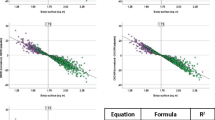Abstract
Adverse drug effects as a consequence of inappropriate dosage are a common cause of hospitalization among the elderly. Older individuals are at a particular risk of overdosing because their kidney function decreases with advancing age and the elderly are often prescribed several pharmaceutical drugs. In addition, serum creatinine levels decrease owing to a reduction in muscle mass with age. Therefore, drug dosing based on the serum creatinine level only, instead of using assessment of the renal function, may result in overdosing of frail elderly patients. Renal function, i.e., the glomerular filtration rate can, with simple formulas, be estimated from analysis of creatinine and/or plasma cystatin C (eGFR). Such estimations performed with modern and validated formulas, as a rule present renal function normalized to the body surface area (mL/min/1.73 m2). A good estimation of how much the normal dosing interval should be prolonged, or the dose reduced, to obtain a desired plasma concentration of drugs that are mainly eliminated by glomerular filtration can be obtained by calculating the ratio between the patient’s eGFR and the normal renal function (about 90–125 mL/min/1.73 m2). Increased knowledge and use of eGFR by prescribing physicians will reduce the risk of overdosing drugs in the elderly.

Similar content being viewed by others
References
Seyffart G. Seyffart’s directory of drug dosage in kidney disease. Oberhaching: Dustri-Verlag Dr. Karl Feistle; 2011.
Blix HS, Viktil KK, Moger TA, Reikvam A. Use of renal risk drugs in hospitalized patients with impaired renal function: an underestimated problem? Nephrol Dial Transplant. 2006;21(11):3164–71. doi:10.1093/ndt/gfl399.
Corsonello A, Pedone C, Lattanzio F, Onder G, Antonelli Incalzi R. Association between glomerular filtration rate and adverse drug reactions in elderly hospitalized patients: the role of the estimating equation. Drugs Aging. 2011;28(5):379–90. doi:10.2165/11588280-000000000-000004.
Hug BL, Witkowski DJ, Sox CM, Keohane CA, Seger DL, Yoon C, et al. Occurrence of adverse, often preventable, events in community hospitals involving nephrotoxic drugs or those excreted by the kidney. Kidney Int. 2009;76(11):1192–8. doi:10.1038/ki.2009.353.
Hellden A, Odar-Cederlof I, Diener P, Barkholt L, Medin C, Svensson JO, et al. High serum concentrations of the acyclovir main metabolite 9-carboxymethoxymethylguanine in renal failure patients with acyclovir-related neuropsychiatric side effects: an observational study. Nephrol Dial Transplant. 2003;18(6):1135–41.
SBU HTA. Methods to estimate and measure renal function (glomerular filtration rate): a systematic review. Report no: 214. Stockholm: Swedish Council on Health Technology Assessment; 2013.
Soveri I, Berg UB, Björk J, Elinder CG, Grubb A, Mejare I, et al. Measuring glomerular filtration rate: a systematic review. Am J Kidney Dis. 2014 (in press).
Elinder CG, Ahlberg M, Allander SV, Alvestrand A, Asker-Hagelberg C, Bell M, et al. Methods to estimate and measure renal function (glomerular filtration rate). In: (SBU) SCoHTA, editor. A systematic review. Stockholm; 2013.
Schaeffner ES, Ebert N, Delanaye P, Frei U, Gaedeke J, Jakob O, et al. Two novel equations to estimate kidney function in persons aged 70 years or older. Ann Intern Med. 2012;157(7):471–81. doi:10.7326/0003-4819-157-7-201210020-000031363512.
Evans M, van Stralen KJ, Schon S, Prutz KG, Stendahl M, Rippe B, et al. Glomerular filtration rate-estimating equations for patients with advanced chronic kidney disease. Nephrol Dial Transplant. 2013. doi:10.1093/ndt/gft226.
Cockcroft DW, Gault MH. Prediction of creatinine clearance from serum creatinine. Nephron. 1976;16(1):31–41.
Dubois D, Dubois EF. A formula to estimate the approximate surface area if height and weight be known. Arch Intern Med. 1916;17:863–71.
Delanaye P, Krzesinski JM. Indexing of renal function parameters by body surface area: intelligence or folly? Nephron Clin Pract. 2011;119(4):c289–92. doi:10.1159/000330276.
Perazella MA. Drug use and nephrotoxicity in the intensive care unit. Kidney Int. 2012;81(12):1172–8. doi:10.1038/ki.2010.475ki2010475.
Thummel KE, Shen DD, Isoherranen N. Appendix II. Design and optimization of dosage regimens: pharmacokinetic data. In: Brunton LL, Chabner BA, Knollmann BC, editors. Goodman & Gilman’s the pharmacological basis of therapeutics. New York: McGraw-Hill; 2011.
Matzke GR, Aronoff GR, Atkinson AJ Jr, Bennett WM, Decker BS, Eckardt KU, et al. Drug dosing consideration in patients with acute and chronic kidney disease: a clinical update from kidney disease: improving global outcomes (KDIGO). Kidney Int. 2011;80(11):1122–37. doi:10.1038/ki.2011.322ki2011322.
Stevens LA, Levey AS. Use of the MDRD study equation to estimate kidney function for drug dosing. Clin Pharmacol Ther. 2009;86(5):465–7. doi:10.1038/clpt.2009.124.
Stevens LA, Nolin TD, Richardson MM, Feldman HI, Lewis JB, Rodby R, et al. Comparison of drug dosing recommendations based on measured GFR and kidney function estimating equations. Am J Kidney Dis. 2009;54(1):33–42. doi:10.1053/j.ajkd.2009.03.008.
Hijazi Z, Hohnloser SH, Oldgren J, Andersson U, Connolly SJ, Eikelboom JW, et al. Efficacy and safety of dabigatran compared with warfarin in relation to baseline renal function in patients with atrial fibrillation: a RE-LY trial analysis. Circulation. 2013. doi:10.1161/CIRCULATIONAHA.113.003628.
Asker-Hagelberg C, Rydberg D, Hentschke M, Holm L, Rosenborg S, Elinder CG. Unclear on dose adjustment in renal impairment. Lakartidningen. 2013;110(21):1030–2.
Nyman HA, Dowling TC, Hudson JQ, Peter WL, Joy MS, Nolin TD. Comparative evaluation of the Cockcroft–Gault equation and the Modification of Diet in Renal Disease (MDRD) study equation for drug dosing: an opinion of the Nephrology Practice and Research Network of the American College of Clinical Pharmacy. Pharmacotherapy. 2011;31(11):1130–44. doi:10.1592/phco.31.11.1130.
Delanaye P, Schaeffner E, Ebert N, Cavalier E, Mariat C, Krzesinski JM, et al. Normal reference values for glomerular filtration rate: what do we really know? Nephrol Dial Transplant. 2012;27(7):2664–72. doi:10.1093/ndt/gfs265gfs265.
McCullough K, Sharma P, Ali T, Khan I, Smith WC, MacLeod A, et al. Measuring the population burden of chronic kidney disease: a systematic literature review of the estimated prevalence of impaired kidney function. Nephrol Dial Transplant. 2012;27(5):1812–21. doi:10.1093/ndt/gfr547.
Conflict of interest
The authors have no conflicts of interest.
Author information
Authors and Affiliations
Corresponding author
Rights and permissions
About this article
Cite this article
Elinder, CG., Bárány, P. & Heimbürger, O. The Use of Estimated Glomerular Filtration Rate for Dose Adjustment of Medications in the Elderly. Drugs Aging 31, 493–499 (2014). https://doi.org/10.1007/s40266-014-0187-z
Published:
Issue Date:
DOI: https://doi.org/10.1007/s40266-014-0187-z



